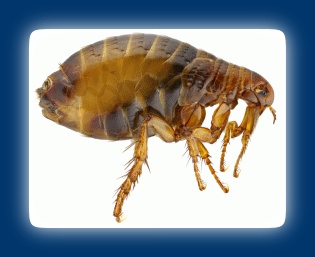|
|







Health - Fleas
How to Treat Cats With Fleas at Home
How to treat cats with fleas at home is something that every responsible cat owner will ask at some point. This article explains just how to do this and starts by explaining a little about fleas, their life cycle and how this helps with treating your cat for fleas.
How to treat cats with fleas at home is something that every responsible cat owner will ask at some point. This article explains just how to do this and starts by explaining a little about fleas, their life cycle and how this helps with treating your cat for fleas.
Your Guide to Effective Flea Treatment in Cats
The common flea (or Ctenocephalides) is a small brown or black insect that simply loves biting and sucking and they can be sized between 1 and 6 mm. With their powerful legs, the flea is able to jump high and far at up to a distance of 30cm – which is what makes them such an elusive adversary to cat owners. There are several species of fleas: but they all have one common characteristic – they are all parasites of animals. The most common are the cat flea and dog flea. However, both of these two species will attack both cats and dogs and can also be transmitted to humans.
Life Cycle and Reproduction of the Flea
In just 48 hours after mating, the female flea begins laying eggs at a fast pace in the fur of your cat who can unfortunately then become the host between 30 to 50 eggs per day for a period of up to 2 months! Eggs drop from the cat and will fall around the house, especially where the animal sleeps. They will then hatch into larvae quickly and will look to live in quiet dark places such as grooves on hardwood floors, cracks at the bottom of walls, under carpets, and in the folds living room sofa – or even worse? bed.
The cat flea larvae will metamorphose into pupae very rapidly into fully grown, hard to shift, adult fleas. In total, the reproductive cycle from egg to adult flea is very short (only about 3 weeks believe it or not), which explains the rapid infestations that can happen in your home and to your poor cat.
Why is the Cat Flea Such a Pest?
The flea will feed on blood of its host cat or a human. Its bite can cause severe itching in cats and humans – with some people experiencing bad allergic reactions. As fleas easily pass from one host to another, they might transmit diseases or parasites, but this is rare so should not be too much of a concern. However, for your own comfort and the happiness of your cat you should still look to eradicate them as soon as possible and as easily as you can.
How to Get Rid of and Treat Cat Fleas?
Anti-flea treatment and eradication of infestation includes three key phases:
01 – Treatment of Your Cat: Treat the cat itself with an anti-flea shampoo, lotion, or spray which can be purchased at pet stores, from a vet, or pharmacy. Simultaneously treat all cats in your household, even those who do not appear infected.
02 – Destruction of Eggs and Larvae: Treat fleas by using a special aerosol on all the objects in your house which will have come into contact with your cat such as sofas, beds, and baskets. Then make sure you carefully vacuum the whole house including all floors, furniture, sofas, and cushions. Better yet, get a steam cleaner in all these areas if you can get hold of one.
03 – Prevention of Flea Re-Infestation: Make sure that you regularly brush your cat’s fur and also regularly administer anti-flea solutions. One of the best ones on the market is called Frontline Plus for Cats as it will start to work within 24 hours of being used. It can be applied as a solution behind the back of their head and will start to work very quickly. As well as solutions, anti-flea medicines for cats can come in oral, shampoo, spot on, powder, and spray format – you need to see which is comfortable for your cat – invariably they will not appreciate you trying to treat them for fleas anyway!
I hope that this introduction to how to treat your cat for fleas has given you enough information in which to safeguard the comfort of not just your favorite pet, but also your home and family.
The common flea (or Ctenocephalides) is a small brown or black insect that simply loves biting and sucking and they can be sized between 1 and 6 mm. With their powerful legs, the flea is able to jump high and far at up to a distance of 30cm – which is what makes them such an elusive adversary to cat owners. There are several species of fleas: but they all have one common characteristic – they are all parasites of animals. The most common are the cat flea and dog flea. However, both of these two species will attack both cats and dogs and can also be transmitted to humans.
Life Cycle and Reproduction of the Flea
In just 48 hours after mating, the female flea begins laying eggs at a fast pace in the fur of your cat who can unfortunately then become the host between 30 to 50 eggs per day for a period of up to 2 months! Eggs drop from the cat and will fall around the house, especially where the animal sleeps. They will then hatch into larvae quickly and will look to live in quiet dark places such as grooves on hardwood floors, cracks at the bottom of walls, under carpets, and in the folds living room sofa – or even worse? bed.
The cat flea larvae will metamorphose into pupae very rapidly into fully grown, hard to shift, adult fleas. In total, the reproductive cycle from egg to adult flea is very short (only about 3 weeks believe it or not), which explains the rapid infestations that can happen in your home and to your poor cat.
Why is the Cat Flea Such a Pest?
The flea will feed on blood of its host cat or a human. Its bite can cause severe itching in cats and humans – with some people experiencing bad allergic reactions. As fleas easily pass from one host to another, they might transmit diseases or parasites, but this is rare so should not be too much of a concern. However, for your own comfort and the happiness of your cat you should still look to eradicate them as soon as possible and as easily as you can.
How to Get Rid of and Treat Cat Fleas?
Anti-flea treatment and eradication of infestation includes three key phases:
01 – Treatment of Your Cat: Treat the cat itself with an anti-flea shampoo, lotion, or spray which can be purchased at pet stores, from a vet, or pharmacy. Simultaneously treat all cats in your household, even those who do not appear infected.
02 – Destruction of Eggs and Larvae: Treat fleas by using a special aerosol on all the objects in your house which will have come into contact with your cat such as sofas, beds, and baskets. Then make sure you carefully vacuum the whole house including all floors, furniture, sofas, and cushions. Better yet, get a steam cleaner in all these areas if you can get hold of one.
03 – Prevention of Flea Re-Infestation: Make sure that you regularly brush your cat’s fur and also regularly administer anti-flea solutions. One of the best ones on the market is called Frontline Plus for Cats as it will start to work within 24 hours of being used. It can be applied as a solution behind the back of their head and will start to work very quickly. As well as solutions, anti-flea medicines for cats can come in oral, shampoo, spot on, powder, and spray format – you need to see which is comfortable for your cat – invariably they will not appreciate you trying to treat them for fleas anyway!
I hope that this introduction to how to treat your cat for fleas has given you enough information in which to safeguard the comfort of not just your favorite pet, but also your home and family.